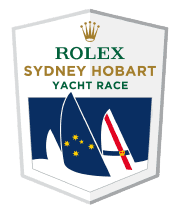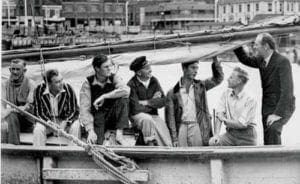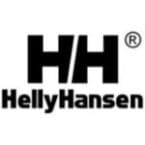Lt Ray Richmond RN (ret), the last surviving member of the winning crew of Rani, the line and handicap winner of the inaugural Sydney Hobart Yacht Race in 1945, has died at the age of 88.
Richmond, then a young engineer officer in the Royal Navy in World War II, became an ocean racing yachtsman by default in 1945 when he was transferred to the Royal Naval Maintenance and Repair Base at Garden Island in Sydney.
His commanding officer was Captain John Illingworth RN, the British Fleet Engineer Officer at Garden Island, and a noted English yachtsman and yacht designer in peace time.
Illingworth had already convinced the fledgling Cruising Yacht Club (of Australia) to turn a planned cruise to Hobart into the now internationally famous Rolex Sydney Hobart Yacht Race.
The 1945 victorious race was Richmond’s one and only long ocean race but he maintained a keen interest in the Sydney Hobart and in 2004 was one of the official starting team to fire the cannons for the 60th Race. His bound scrap-book is a wonderful historic record of the first Sydney Hobart.
He died peacefully last week at Bowral in the Southern Highlands of New South Wales where he and his wife Alison Gwendoline retired to some years ago after postings in several countries with Burma Oil following his discharge from the Royal Navy.
In 1945, Ray Richmond was a young engineer lieutenant attached to the British Pacific Fleet in Tokyo Bay when he was transferred at short notice to Sydney. One of his first tasks was to assist Captain Illingworth prepare Rani for the Sydney Hobart Race, due to start on Boxing Day, 26 December 1945, including scrubbing and painting the bottom of the wooden hull.
Rani was a double-ended 35-footer, designed by Arthur Barber and built in Sydney. Illingworth enlisted a crew of young Royal Navy officers and local amateur yachtsmen and set about tuning up the yacht for the 630 nautical mile race south to Tasmania. Rani was the smallest of the nine starters.
In an interview with Offshore Yachting’s editor at large Peter Campbell before the 60th Rolex Sydney Hobart Yacht Race, Richmond vividly recalled the start of the 1945 race, the subsequent voyage south battling galeforce winds and wild seas in the Tasman Sea, and the crew’s surprise at discovering they were the first boat to reach Hobart.
“Illingworth was a master tactician; a keen ocean racer,” Richmond recalled. “We plotted every mile of the way. Every half hour of every watch we had to put down our estimated position, which Illingworth or the navigator checked on the course.”
Radios were not compulsory in those days. Rani had one on loan from a Royal Navy aircraft carrier but two valves burned out before the start. “So we set sail with no ship to shore communications whatsoever,” Richard said. “No one on board cared anyway…no life rafts, rescue ships, no helicopters to take take you off or guide you if you got lost.”
On the afternoon of the second day of the race, a ‘southerly buster’ hit the fleet, developing into a force 9 gale. All yachts except Rani hove to or ran for shelter. One retired, with the storm lasting for 36 hours.
When neither race officials nor the RAAF were able to make contact by radio or in search sweeps off the NSW South Coast, grave fears were held for Rani, the smallest boat in the fleet.
“Of the storm, I can only say it was force 9, according to the RAAF,” Richmond recalled. “The waves were reported as being 50 feet high. We were pooped. I was on the helm at the time. We had been heading just ahead of the wage and we went down vertically, straight down and popped up again.”
Rani ripped her mainsail, but Australian crew member Norman Hudson repaired it and Rani continued on across eastern Bass Strait and to the Tasmanian east coast.
Richmond recalled one other problem that the crew, and he in particular, encountered during the storm. “I learned quickly that if you are going to stow tins and bottles below the floor of the cabin, be sure to take off the bloody labels and paint on the tins their contents. We didn’t and the labels floated off.
“The bilge pump became choked with paper pulp and we did not what we were eating until we opened the cans, sometimes it was baked beans for dinner and custard for breakfast!”
The storm was inevitably followed by a calm and the voyage south dragged on and on. “Coming into Storm Bay we were very despondent,” Richmond recalled. “Six days it had taken us…we were the smallest boat in the fleet.”
An RAAF Catalina eventually sighted Rani in Storm Bay, but the crew of the yacht were still convinced that they were the ‘Tail-end Charlie’ in the fleet.
Later that night, as they sailed up the Derwent River the crew sighted the headlights of a car flashing out in Morse code: “Are you Rani?” “Yes, we’re Rani,” they replied. Then a further message flashed from ashore: “Thank God you’re safe.”
Long afterwards a launch came alongside Rani, “greeting us fervently”, as Richmond recalled. When Captain Illingworth asked: “How are we doing”, his question was followed by “raucous laughter” from the launch crew who apparently had been celebrating New Year at the Royal Yacht Club of Tasmania.
Illingworth had then asked: “How many boats are in?” He was answered with more raucous laughter and told: “You’re the first!” and handed a bottle of whiskey. “We didn’t pull the cork until we had cross the line and berthed in Sullivan’s Cove,” claimed Richmond, where Rani and her crew were given a hero’s welcome by hundreds of Hobartians lining the waterfront near historic Constitution Dock.
Lt Ray Richmond RN and his English and Australian crew mates aboard Rani – Captain John Illingworth RN (owner/skipper), Geoff Colohan, Lt John Hoggard RN, Norman Hudson, Captain Ken Vaughan AIF and Lt Bill Mews RNVR – thus made history as the winners of the inaugural Sydney Hobart Yacht Race in 1945, an event that has become one of the great ocean races of the world and an icon of Australian summer sport.
Rani remains the smallest boat ever to take line honours in the 63 years of the Rolex Sydney Hobart Yacht Race and is one of only six boats to have taken the double of line and overall handicap honours. It was a remarkable feat and earned Captain Illingworth the well deserved title of ‘father of modern ocean racing in Australia.’
Ray Richmond returned to civilian life as an engineer with Burma Oil, working back in Britain and at various overseas postings, including Karachi, Hong Kong and in the USA, before returning to Australia and retiring to the Southern Highlands of NSW. Whilst he continued sailing, it was mainly in dinghies and small keelboats. The 1945 Hobart Race was his one and only ocean race.
He is survived by his wife Alison Gwendoline and also by his first wife, Dorothy and their two children, David and Gillian.
A funeral service for Lt Ray Richmond RN (ret) will be held at 12 noon on Monday 23 June at St Judes Anglican Church, Bowral.



























